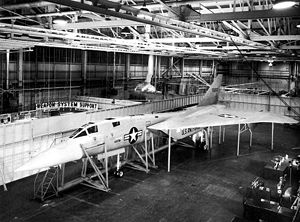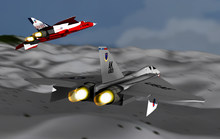North American XF-108 Rapier Video - Documentary
|
|
North American XF-108 Rapier
XF-108 Rapier

Role: Interceptor
Manufacturer: North American Aviation
Status: Cancelled (1959)
Number built: 1 mock-up
Unit cost: US$141.9 million for the program
The North American XF-108 Rapier was a proposed American design for a long-range, high-speed interceptor aircraft to defend the United States and Canada from supersonic Soviet bombers.
Development history
A very high performance, long-range interceptor had been proposed by the USAF as early as 1952, but formal development of what became known as the Long-Range Interceptor, Experimental (LRI-X) was not approved until 20 July 1955. The specification was laid down on 6 October, calling for an interceptor that could fly at 60,000 ft (18,000 m) at a speed of Mach 1.7 (1,122 mph (1,806 km/h) at that altitude) with a range of 1,150 miles (1,850 km). It was to have a two-man crew, at least two engines and a powerful radar. A further consideration was that an integrated fire control system would be fitted allowing interception of a bomber at 60 nautical miles (110 km; 69 mi) and that three targets could be destroyed during a single mission.
Contracts for preliminary studies were issued to North American Aviation, Lockheed and Northrop. Of the paper designs, the North American proposal, dubbed NA-236, seemed most promising. Political and budgetary difficulties led to the cancellation of the program on 9 May 1956. After considerable confusion, the program was reinstated on 11 April 1957 with North American awarded a contract for two prototypes. The designation F-108 was issued, also known as Weapon System 202A. North American's company designation was NA-257, although it was basically identical to NA-236. At the time, Air Defense Command anticipated an order for 480 aircraft.
The resulting design went through considerable evolution, both owing to its cutting-edge technology and continual redefinition of the USAF requirements. In addition to the F-108's interceptor role, North American proposed it as an escort fighter for the NAA-proposed B-70 supersonic bomber. The "F-108 development was to 'precede' the B-70 bomber, and a portion of the "150 million dollars expended" on the F-108 through September 1959 was of direct application to the XB-70 Valkyrie. Commonality between the B-70 bomber and the F-108 included the escape capsule and General Electric YJ93 engines.
From September 1958, when substantial engineering and design changes were implemented, however, SAC had lost interest in the escort fighter concept. To accompany the B-70 all the way to its target and back, the F-108 in its initial concept would have, at best, marginal range.
The eventual design, which was built as a full-sized XF-108 mock-up, was shown on 17-20 January 1959 to Air Force officials. The project was given the name "Rapier" on 15 May 1959 following a contest by the Air Defense Command asking airmen for suggestions.
Design
The initial F-108 configuration featured a very large "cranked" delta wing, with a 58° sweep angle at the leading edge and wingtip extensions of about 40°, with a 4° anhedral. There were fixed ventral stabilizers on the wings, mounted at mid-span, and a tall all-moving vertical tailfin, supplemented by two ventral stabilizers that extended when the landing gear retracted. Although some earlier versions of the design had had separate tailplanes and later forward canards, both were abandoned in the final design.
The aircraft was powered by two General Electric J93 turbojet engines, also used in North American's XB-70 Valkyrie bomber, in the fuselage; USAF requests for an alternate installation of the Pratt & Whitney J58 later used in the SR-71 came to naught. The engines were fed by side-mounted intakes with a shape very similar to the North American A-5 Vigilante.
The large fuselage and wing had nine fuel tanks for a total of 7,109 US gallons (26,910 L) of JP-6 fuel, giving an estimated combat radius of some 1,100 nautical miles (2,000 km; 1,300 mi), which could be extended by in-flight refueling. Top speed was estimated at 1,980 miles per hour (3,190 km/h), about Mach 3, at 72,800 feet (22,200 m). It was stressed for +5.33/-3.00 g.
The aircraft had a crew of two, a pilot and a weapon systems officer (WSO), in a tandem cockpit arrangement. Each crewman had an escape capsule designed to permit safe ejection even at extreme speeds and altitudes. The weapon systems operator in the rear seat had no flight controls.
The F-108 was intended to carry the Hughes AN/ASG-18 radar, the U.S.'s first pulse doppler radar set. It was to have look-down/shoot-down capability, but could only track one target at a time. It was a massive 2,100-pound (950 kg) installation filling most of the long nose. The radar was paired with an infrared search and track (IRST) system on the wing leading edges.

Picture - Artist's impression of F-108 assigned to Elmendorf AFB as an interceptor aircraft
The radar was used to guide the Hughes GAR-9 (later redesignated AIM-47) air-to-air missile, three of which would be carried on a rotary launcher in an internal weapons bay. The F-111B and later F-14 Tomcat would both adopt a pulse doppler radar and long range AIM-54 Phoenix missiles similar to the AIM-47. The GAR-9 was a very large, long-range weapon with its own radar set for terminal homing. It was intended to fly at Mach 6, with a range of almost 115 miles (185 km). An alternative version with a heat-seeking terminal homing mode was also developed. The missiles were 12.55 feet (3.83 m) long with a 33 inches (840 mm) wingspan, weighing 818 pounds (371 kg) for the radar version, 998 lb (453 kg) for the IR version. The earlier Northrop N-126 proposal suggested various weapons combinations, including GAR-1 Falcon missiles, packs of 2.75 inches (70 mm) FFARs, or two T-171 Vulcan 20 mm (0.79 in) cannon, but none were part of the North American design.
Development of the F-108 radar and missiles was continued by the USAF and the system was eventually used in the Lockheed YF-12 program. The final configuration for the rear cockpit in the YF-12A looked similar to that of the F-108 since it incorporated the same displays and controls required for the Hughes ASG-18 fire control system.
Cancellation
On 30 December 1958, YF-108A pre-production aircraft on order were reduced from 31 to 20 test aircraft and the first test flight was delayed from February to April 1961. On 16 September 1959, after President Eisenhower identified the military financial situation as "getting quite serious", Secretary of Defense Neil H. McElroy informed him of a reduction of 27,000 USAF personnel and that the "F-108 project is expected to be cancelled within thirty days." The cancellation was announced on 23 September and identified that Hughes Aircraft would continue development of the advanced fire control system and the GAR-9 missile. North American kept refining the design through 1960 in hopes that the program might be revived.
However, the money and time spent on the Rapier was not wholly in vain - the A-5 Vigilante supersonic bomber/reconnaissance aircraft developed for the U.S. Navy retained the fuselage/weapon package and systems design of the Rapier. In many ways the Vigilante can be seen as the successful application of the Rapier design principles in a Mach 2 supersonic bomber design.
Specifications (XF-108, as designed)
Data from
General characteristics
Crew: 2
Length: 89.2 ft (27.2 m)
Wingspan: 57.4 ft (17.5 m)
Height: 22.1 ft (6.7 m)
Wing area: 1,865 ft² (173.4 m²)
Empty weight: 50,907 lb (23,098 kg)
Max takeoff weight: 102,000 lb (46,508 kg)
Powerplant: 2x— General Electric YJ93-GE-3AR afterburning turbojet
Dry thrust: 20,900 lbf (93.0 kN) each
Thrust with afterburner: 29,300 lbf (130.3 kN) each
Performance
Maximum speed: Mach 2.6, 1,980 mph (1,720 kn, 3,190 km/h)
Range: 1,271 mi (1,104 NM, 2,033 km) combat
Ferry range: 2,488 mi (2,162 NM, 4,004 km)
Service ceiling: 80,100 ft (24,400 m)
Wing loading: 55.9 lb/ft² (183.4 kg/m²)
Thrust/weight: 0.56
Armament
Guns: 4 x 20 mm cannon
Missiles: 3 x— Hughes GAR-9A air-to-air missiles in a rotary weapons bay
Bombs: 4,000 lbs
Related development
A-5 Vigilante
Comparable aircraft
CF-105 Arrow
Mikoyan-Gurevich MiG-25
Mikoyan MiG-31
Republic XF-103
Tupolev Tu-28
UK F.155 project
Bibliography
Buttler, Tony. American Secret Projects, Fighters & Interceptors 1945-1978. Hinckley, UK: Midland Publishing. 2007. ISBN 1-85780-264-0.
Dorr, Robert F. and Jon Lake. Fighters of the United States Air Force. London: Temple Press, 1990. ISBN 0-600-55094-X.
Jenkins, Dennis R. and Tony R. Landis. "F-108 Rapier The Elusive Mach 3 Interceptor." Airpower, Volume 34, no. 9, September 2004.
Knaack, Marcelle Size. Encyclopedia of US Air Force Aircraft and Missile Systems: Volume 1 Post-World War II Fighters 1945-1973. Washington, DC: Office of Air Force History, 1978. ISBN 0-912799-59-5.
Pace, Steve. "Supersonic Cavaliers." Airpower, Volume 16, no. 6, November 1986.
Pace, Steve. X-Fighters: USAF Experimental and Prototype Fighters, XP-59 to YF-23. Osceola, Wisconsin: Motorbooks International, 1991. ISBN 0-87938-540-5.
Living Warbirds: The best warbirds DVD series.
Source: WikiPedia